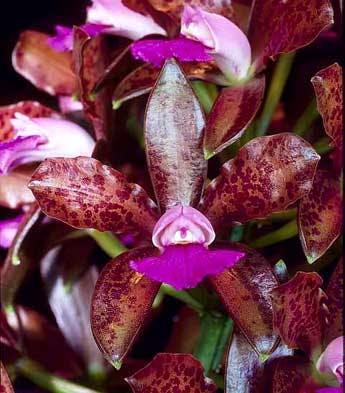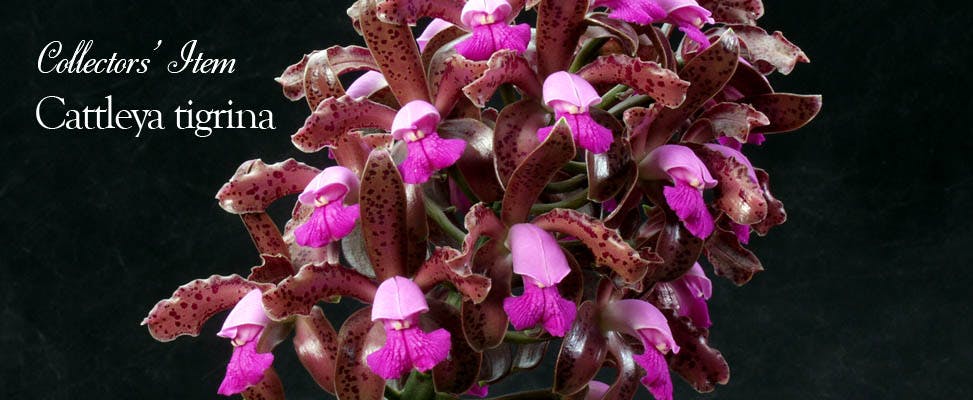
Cattleya tigrina (awarded as C. leopoldii) 'Michael' AM/AOS exhibited by Bill Rogerson, photo by Rhonda Peters



Cattleya tigrina (awarded as C. leopoldii) 'Michael' AM/AOS exhibited by Bill Rogerson, photo by Rhonda Peters
One of the pleasures of collecting Brazil's bifoliate cattleyas is that with the exception of the late autumn months, there are species in bloom throughout the year providing the grower with satisfying variations in color, form, fragrance and plant habit. As I write this on the last day of June, we have had Cattleya tigrina plants in bloom now for couple of weeks and I have seen others at AOS judgings. The species is blooming late this year, as are many orchids, due to an extended cold spell in January. C. tigrina typically flowers the end of May and into June in the Northern Hemisphere - about the same time as that other Brazilian favorite, Cattleya purpurata¹.
Long known as Cattleya leopoldii Verschaff. ex Lem. and before that, Cattleya guttatavar. leopoldii (Verschaff. ex Lem.) Linden & Rchb.f.. This orchid is still confused by many with Cattleya guttata. It is true that both have spotted flowers and a bright fuchia midlobe of the lip, but there are more differences than similarities between the two. Identifying the two will be the topic of another essay, but for now, the easiest way to tell C. tigrina and C. guttata apart is by blooming season. C. tigrina flowers in early summer from a green sheath, whereas C. guttata flowers in late summer (or early autumn) from a dried sheath.
Cattleya tigrina was first published by Achille Richard in 1848 in the French publication, Portefeuillie des horticulteurs. The description is accompanied by a color plate that seems to clearly represent the species we are writing about here. Two years later M . Verschaffelt collected the plant in Santa Catarina and in a politically correct move, named itCattleya leopoldii after King Leopold I of Belgium who was an ardent supporter of horticulture. He did not formally publish the species though, so it was up to Charles Lemaire to formalize it and provide a description in L'illustration horticole Vol II p. 68, 1855 (although a note without latinized description appeared in Vol I of the same periodical a year earlier). Fowlie² contended that among other reasons, no type existed for Richard's description and that Cattleya tigrina was a nomen obscurum. Braem argued that "just because a type has not been found does not mean that it doesn't exist" and "the type of Cattleya tigrinais awaiting rediscovery among other sheets somewhere in a herbarium, probably in Paris". As it turns out, there is indeed a type specimen dated 1838 in the Muséum National D'Histoire Naturelle...in Paris!
Cattleya tigrina is a species that inhabits coastal swamps of Brazil from south of Rio de Janeiro south to Rio Grande do Sul. It is rarely found much above three or four hundred feet elevation. Parts of its range overlap those of C. intermedia and C. purpurata and there are naturally occurring hybrids with both species. Cattleya x elegans (C. tigrina x C. purpurata) has been occasionally seen in the trade over the years and artifically made using various forms of C. purpurata. There are several color forms of the species including immaculata, coerulea and alba, representing a dark form with coalesced spots, a pale form with bluish lip, and green flowers with white lip (lacking anthocyanin). The latter have been sold over the years as C. guttata var. alba, which they are not.

Cattleya tigrina grown and photographed by Greg Allikas
Cattleya tigrina is not for the meek; this is a robust orchid that can grow two to three feet tall and produce many-flowered inflorescences. And that is exactly what makes it so wonderful! The individual flowers are not especially large, averaging about three inches across. What they lack in size they make up for in numbers, with mature plants capable of producing 30 or more flowers per inflorescence! The flowers have a strong spicy fragrance that I can best describe as smelling like bubblegum.
Although Cattleya tigrina is a large orchid, it can be grown in small greenhouses, or even windowsills, by keeping it in small pots. It may eventually outgrow its alotted space at which time it can be divided and shared with friends. A six inch pot will accommodate a mature, flowering size plant. Here in our South Florida shade house we like to grow large orchids, so as plants of C. tigrina get bigger, we eventually move them up to eight or nine inch pots. If you are growing this or other large orchid in a six inch pot or larger, it is important to allow air at the roots in order to maintain their good health. We pot in clay pots and enlarge the center drainage hole by tapping the edges with lineman's pliers. With large pots sizes, we often use an inverted net pot over the drainage hole to provide extra aeration and fill the bottom of the pot with large inert material such as landscape lava rock, charcoal or broken chunks of styrofoam packing. Most importantly, regardless of the pot size, use large size media, either fir bark or coconut chunks. Mixing in large grade diatomite or lava rock also works well to keep the pot interior from getting stale and soggy.
Cattleya tigrina will grow in the same light as your other cattleyas, although it can stand quite bright light if acclimated gradually (up to 3500fc). The only other major consideration is when to repot. Bifoliate cattleyas in general, are intolerant of stale media. They do not tolerate potting at the wrong time either. As with all orchids, the best time to repot is when there is active root growth, preferably a cluster of root tips at the base of a new lead. This does not always work out with C. tigrina because it flowers directly from a recently matured growth which has begun some root growth. We like to wait until a second flush of roots begins, usually a month or so after flowering. There should be active root growth in any case and some roots will be well developed. Be as gentle as possible with these longer roots and work the old media away carefully. If the media is in good condition you can leave some of it attached and merely move the orchid up to a bigger pot, and fill in around the root mass.
Fertilize as you do your other sympodial orchids and keep the temperature range between 85º and 50º F year-round, although plants will tolerate extremes for short periods.
Greg Allikas, June 2010
1) formerly Laelia purpurata
2) Fowlie, J.A. 1977. The Brazilian Bifoliate Cattleyas and Their Color Varieties. Azul Quinta Press. La Canada, California. p.95.
3) Braem, Guido J. 1984. Die bifoliaten Cattleyen Brasiliens Brücke-verlag, Kurt Schmerson, Hildesheim, Germany. p.75.

Get notified when orchid vendors have special promotions and exclusive savings.
